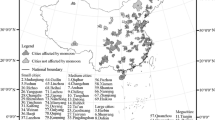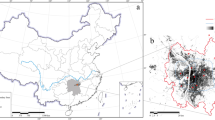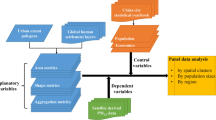Abstract
Context
Understanding the urban form-air quality relationship is essential to mitigate intra-urban air pollution and to improve urban ecology. However, few studies considered urban form and meteorological factors integratively and analyzed their synthetic effects on air pollution.
Objectives
We investigate how to model the integrated effects on the spatiotemporal distribution of PM2.5 in the Atlanta metropolitan area to improve the understanding of the urban form-air quality relationship.
Methods
Two groups of models are developed: one uses urban form only and the other uses wind-direct urban form. Relative humidity, wind speed, and temperature are included as control variables. Both linear (Multiple Linear Regression) and nonlinear models (Random Forest and Artificial Neural Network) are constructed and tested with both tenfold cross-validation and field PM2.5 data obtained from a portable device, AirBeam2.
Results
Random Forest overall outperforms other models suggesting that the urban form-air quality relationship is most likely to be nonlinear. Additionally, the group using wind-direct urban form outperforms the other group and the contribution of the same urban form metrics differs in different wind sections proving that meteorological factors and urban form have synthetic effects on PM2.5. Finally, the patch density, dominance, and aggregation of roads and vegetation, demonstrate higher attribute significance than other urban form metrics.
Conclusions
Urban planners, practitioners, and policymakers need to carefully consider not only the spatial configuration of roads and vegetation but also the local climate patterns to minimize intra-urban air pollution effectively.





Similar content being viewed by others
References
Arain M, Blair R, Finkelstein N, Brook J, Sahsuvaroglu T, Beckerman B, Zhang L, Jerrett M (2007) The use of wind fields in a land use regression model to predict air pollution concentrations for health exposure studies. Atmos Environ 41:3453–3464
Avise J, Chen J, Lamb B, Wiedinmyer C, Guenther A, Salathé E, Mass C (2009) Attribution of projected changes in summertime US ozone and PM2. 5 concentrations to global changes. Atmos Chem Phys 9:1111–1124
Barker JR, Tingey DT (2012) Air pollution effects on biodiversity. Springer, Berlin
Bechle MJ, Millet DB, Marshall JD (2011) Effects of income and urban form on urban NO2: global evidence from satellites. Environ Sci Technol 45:4914–4919
Bereitschaft B, Debbage K (2013) Urban form, air pollution, and CO2 emissions in large US metropolitan areas. Prof Geogr 65:612–635
Biau G, Scornet E (2016) A random forest guided tour. Test 25:197–227
Borrego C, Martins H, Tchepel O, Salmim L, Monteiro A, Miranda AI (2006) How urban structure can affect city sustainability from an air quality perspective. Environ Model Softw 21:461–467
Boznar M, Lesjak M, Mlakar P (1993) A neural network-based method for short-term predictions of ambient SO2 concentrations in highly polluted industrial areas of complex terrain. Atmos Environ Part B Urban Atmos 27:221–230
Breiman L (2001) Random forests. Machine Learn 45:5–32
Brokamp C, Jandarov R, Rao M, LeMasters G, Ryan P (2017) Exposure assessment models for elemental components of particulate matter in an urban environment: a comparison of regression and random forest approaches. Atmos Environ 151:1–11
Brookings (2003) Atlanta in focus: a profile from Census 2000. Available at www.brookings.edu/research/atlanta-in-focus-a-profile-from-census-2000
Brunekreef B, Holgate ST (2002) Air pollution and health. Lancet 360:1233–1242
Bureau USC (2018). Available at www.census.gov
Buyantuyev A, Wu J, Gries C (2010) Multiscale analysis of the urbanization pattern of the Phoenix metropolitan landscape of USA: time, space and thematic resolution. Landsc Urban Plan 94:206–217
Cho H-S, Choi M (2014) Effects of compact urban development on air pollution: empirical evidence from Korea. Sustainability 6:5968–5982
Contreras L, Ferri C (2016) Wind-sensitive interpolation of urban air pollution forecasts. Procedia Comput Sci 80:313–323
Covello VT, Merkhoher MW (2013) Risk assessment methods: approaches for assessing health and environmental risks. Springer, New York
De Groot RS, Alkemade R, Braat L, Hein L, Willemen L (2010) Challenges in integrating the concept of ecosystem services and values in landscape planning, management and decision making. Ecol Complex 7:260–272
De Hoogh K, Wang M, Adam M, Badaloni C, Beelen R, Birk M, Cesaroni G, Cirach M, Declercq C, Dedele A (2013) Development of land use regression models for particle composition in twenty study areas in Europe. Environ Sci Technol 47:5778–5786
Donnelly A, Naughton O, Misstear B, Broderick B (2016) Maximizing the spatial representativeness of NO2 monitoring data using a combination of local wind-based sectoral division and seasonal and diurnal correction factors. J Environ Sci Health Part A 51:1003–1011
Dulal HB, Brodnig G, Onoriose CG (2011) Climate change mitigation in the transport sector through urban planning: a review. Habitat Int 35:494–500
Edussuriya PS, Chan A (2015) Analysis of urban morphological attributes and street level air pollution in high-density residential environments in Hong Kong. Living and learning: Research for a better built environment. 49th International Conference of the Architectural Science AssociaTion 2015. The Architectural Science Association and The University of Melbourne, Melbourne
Elminir HK (2005) Dependence of urban air pollutants on meteorology. Sci Total Environ 350:225–237
Gardner MW, Dorling S (1998) Artificial neural networks (the multilayer perceptron)—a review of applications in the atmospheric sciences. Atmos Environ 32:2627–2636
GDOT (2020) Traffic Analysis & Data Application (TADA). Available at https://www.dot.ga.gov
Georgescu M (2015) Challenges associated with adaptation to future urban expansion. J Clim 28:2544–2563
Georgii H, Busch E, Weber E (1967) Investigation of the temporal and spectral distribution of the emission concentration of carbon monoxide in Frankfurt/Main, Rept. No. 11. Institute for Meteorology and Geophysics, Univ of Frankfurt/Main, Frankfurt
Ghassoun Y, Löwner M-O (2017) Land use regression models for total particle number concentrations using 2D, 3D and semantic parameters. Atmos Environ 166:362–373
Guidance E (2001) Improving air quality through land use activities. Transportation and Regional Programs, Division Office of Transportation and Air Quality, US Environmental Protection Agency, Washington, DC
Gwinnett Citizen (2018) Atlanta air quality Worsened, Finds 2018 ‘State of the Air’ Report
Habermann M, Billger M, Haeger-Eugensson M (2015) Land use regression as method to model air pollution. Previous results for Gothenburg/Sweden. Procedia Eng 115:21–28
HabitatMap (2018). Available at www.habitatmap.org/aircasting
Hall MA (1999) Correlation-based feature selection for machine learning
Hamilton J (2012) Careers in environmental remediation. Office of Occupational Statistics and Employment Projections, US Bureau, Washington, DC
Haykin S (2010) Neural networks and learning machines, 3/E. Pearson Education, Bengaluru
He HS, DeZonia BE, Mladenoff DJ (2000) An aggregation index (AI) to quantify spatial patterns of landscapes. Landsc Ecol 15:591–601
Heald C, Henze D, Horowitz L, Feddema J, Lamarque JF, Guenther A, Hess P, Vitt F, Seinfeld J, Goldstein A (2008) Predicted change in global secondary organic aerosol concentrations in response to future climate, emissions, and land use change. J Geophys Res Atmos 113
Hien P, Loc P, Dao N (2011) Air pollution episodes associated with East Asian winter monsoons. Sci Total Environ 409:5063–5068
Hoek G, Beelen R, De Hoogh K, Vienneau D, Gulliver J, Fischer P, Briggs D (2008) A review of land-use regression models to assess spatial variation of outdoor air pollution. Atmos Environ 42:7561–7578
Hornik K, Stinchcombe M, White H (1989) Multilayer feedforward networks are universal approximators. Neural Netw 2:359–366
Irwin EG, Bockstael NE (2007) The evolution of urban sprawl: evidence of spatial heterogeneity and increasing land fragmentation. Proc Natl Acad Sci 104:20672–20677
Jacob DJ, Winner DA (2009) Effect of climate change on air quality. Atmos Environ 43:51–63
Jang W, Yao X (2014) Tracking ethnically divided commuting patterns over time: a case study of Atlanta. Prof Geogr 66:274–283
Janhäll S (2015) Review on urban vegetation and particle air pollution–deposition and dispersion. Atmos Environ 105:130–137
Jiang W, Wang Y, Tsou M-H, Fu X (2015) Using social media to detect outdoor air pollution and monitor air quality index (AQI): a geo-targeted spatiotemporal analysis framework with Sina Weibo (Chinese Twitter). PLoS ONE 10:e0141185
Kohonen T (1988) An introduction to neural computing. Neural Netw 1:3–16
Larkin A, van Donkelaar A, Geddes JA, Martin RV, Hystad P (2016) Relationships between changes in urban characteristics and air quality in East Asia from 2000 to 2010. Environ Sci Technol 50:9142–9149
Li X, Liu W, Chen Z, Zeng G, Hu C, León T, Liang J, Huang G, Gao Z, Li Z (2015) The application of semicircular-buffer-based land use regression models incorporating wind direction in predicting quarterly NO2 and PM10 concentrations. Atmos Environ 103:18–24
Li Y, Chen Q, Zhao H, Wang L, Tao R (2015b) Variations in PM10, PM2.5 and PM1.0 in an urban area of the Sichuan Basin and their relation to meteorological factors. Atmosphere 6:150–163
Lin H, Ma W, Qiu H, Wang X, Trevathan E, Yao Z, Dong G-H, Vaughn MG, Qian Z, Tian L (2017) Using daily excessive concentration hours to explore the short-term mortality effects of ambient PM2. 5 in Hong Kong. Environ Pollut 229:896–901
Liu Y, Wu J, Yu D (2017) Characterizing spatiotemporal patterns of air pollution in China: a multiscale landscape approach. Ecol Ind 76:344–356
Liu Y, Wu J, Yu D (2018a) Disentangling the complex effects of socioeconomic, climatic, and urban form factors on air pollution: a case study of China. Sustainability 10:776
Liu Y, Wu J, Yu D, Hao R (2018b) Understanding the patterns and drivers of air pollution on multiple time scales: the case of northern China. Environ Manag 61:1048–1061
Liu Y, Wu J, Yu D, Ma Q (2018c) The relationship between urban form and air pollution depends on seasonality and city size. Environ Sci Pollut Res. 25(16):15554–15567
Lu C, Liu Y (2016) Effects of China’s urban form on urban air quality. Urban Stud 53:2607–2623
Luo J, Du P, Samat A, Xia J, Che M, Xue Z (2017a) Spatiotemporal pattern of PM 2.5 concentrations in mainland China and analysis of its influencing factors using geographically weighted regression. Sci Rep 7:1–14
Luo J, Du P, Samat A, Xia J, Che M, Xue Z (2017b) Spatiotemporal pattern of PM 2.5 concentrations in mainland China and analysis of its influencing factors using geographically weighted regression. Sci Rep 7:40607
Marquez LO, Smith NC (1999) A framework for linking urban form and air quality. Environ Model Softw 14:541–548
Marshall JD, McKone TE, Deakin E, Nazaroff WW (2005) Inhalation of motor vehicle emissions: effects of urban population and land area. Atmos Environ 39:283–295
Martins H (2012) Urban compaction or dispersion? An air quality modelling study. Atmos Environ 54:60–72
McCarty J, Kaza N (2015) Urban form and air quality in the United States. Landsc Urban Plan 139:168–179
McCulloch WS, Pitts W (1943) A logical calculus of the ideas immanent in nervous activity. Bull Math Biophys 5:115–133
McGarigal K, Cushman SA, Ene E (2012) FRAGSTATS v4: spatial pattern analysis program for categorical and continuous maps. Computer software program produced by the authors at the University of Massachusetts, Amherst. Available at http://www.umass.edu/landeco/research/fragstats/fragstats.html
Meng X, Chen L, Cai J, Zou B, Wu C-F, Fu Q, Zhang Y, Liu Y, Kan H (2015) A land use regression model for estimating the NO2 concentration in Shanghai, China. Enviro Res 137:308–315
Met-Office (2015) Beaufort wind force scale. Available at https://www.metoffice.gov.uk/weather/guides/coast-and-sea/beaufort-scale
Mikhailuta SV, Lezhenin AA, Pitt A, Taseiko OV (2017) Urban wind fields: phenomena in transformation. Urban Clim 19:122–140
Naughton O, Donnelly A, Nolan P, Pilla F, Misstear B, Broderick B (2018) A land use regression model for explaining spatial variation in air pollution levels using a wind sector based approach. Sci Total Environ 630:1324–1334
NOAA (2010) 1981–2010 U.S. Climate Normals. National Climatic Data Center
NOAA (2017) Global climate report-annual 2017. NCEI, NOAA, Asheville
Ou J, Liu X, Li X, Chen Y (2013) Quantifying the relationship between urban forms and carbon emissions using panel data analysis. Landsc Ecol 28:1889–1907
Pope CA III, Dockery DW (2006) Health effects of fine particulate air pollution: lines that connect. J Air Waste Manag Assoc 56:709–742
Pye H, Liao H, Wu S, Mickley LJ, Jacob DJ, Henze DK, Seinfeld J (2009) Effect of changes in climate and emissions on future sulfate-nitrate-ammonium aerosol levels in the United States. J Geophys Res Atmos
Qin S, Liu F, Wang J, Sun B (2014) Analysis and forecasting of the particulate matter (PM) concentration levels over four major cities of China using hybrid models. Atmos Environ 98:665–675
Rajan SC (2006) Climate change dilemma: technology, social change or both? An examination of long-term transport policy choices in the United States. Energy Policy 34:664–679
Renhe Z, Li Q, Zhang R (2014) Meteorological conditions for the persistent severe fog and haze event over eastern China in January 2013. Sci China Earth Sci 57:26–35
Rodríguez MC, Dupont-Courtade L, Oueslati W (2016) Air pollution and urban structure linkages: evidence from European cities. Renew Sustain Energy Rev 53:1–9
Samuel M (2015) Following The Trail Of Atlanta’s Winter Air Pollution. Wabe. Availale at https://cp.wabe.org/post/following-trail-atlantas-winter-air-pollution
Seaman NL (2000) Meteorological modeling for air-quality assessments. Atmos Environ 34:2231–2259
She Q, Peng X, Xu Q, Long L, Wei N, Liu M, Jia W, Zhou T, Han J, Xiang W (2017) Air quality and its response to satellite-derived urban form in the Yangtze River Delta, China. Ecol Ind 75:297–306
Shen J, Gao Z, Ding W, Yu Y (2017) An investigation on the effect of street morphology to ambient air quality using six real-world cases. Atmos Environ 164:85–101
Shi Y, Lau KK, Ng E (2016) Developing street-level PM2.5 and PM10 land use regression models in high-density Hong Kong with urban morphological factors. Environ Sci Technol 50:8178–8187
Shi Y, Lau KK-L, Ng E (2017) Incorporating wind availability into land use regression modelling of air quality in mountainous high-density urban environment. Environ Res 157:17–29
Shi Y, Ren C, Lau KK-L, Ng E (2019) Investigating the influence of urban land use and landscape pattern on PM2.5 spatial variation using mobile monitoring and WUDAPT. Landsc Urban plan 189:15–26
Silva LT, Monteiro JP (2016) The Influence of Urban Form on Environmental Quality within a Medium-sized City. Procedia Eng 161:2046–2052
Simpson JE (1994) Sea breeze and local winds. Cambridge University Press, Cambridge
Stone B Jr (2008) Urban sprawl and air quality in large US cities. J Environ Manag 86:688–698
Suleiman A, Tight M, Quinn A (2016) Assessment and prediction of the impact of road transport on ambient concentrations of particulate matter PM10. Transp Res Part D Transp Environ 49:301–312
Tian Y, Yao X, Chen L (2019) Analysis of spatial and seasonal distributions of air pollutants by incorporating urban morphological characteristics. Comput Environ Urban Syst 75:35–48
Tsai Y-H (2005) Quantifying urban form: compactness versus’ sprawl’. Urban Stud 42:141–161
Vienneau D, De Hoogh K, Briggs D (2009) A GIS-based method for modelling air pollution exposures across Europe. Sci Total Environ 408:255–266
Witten IH, Frank E, Hall MA (2016) Data Mining: Practical machine learning tools and techniques, 3rd edn. Morgan Kaufmann, Burlington
Wu J, Xie W, Li W, Li J (2015) Effects of urban landscape pattern on PM2.5 pollution—a Beijing case study. PLoS ONE 10:e0142449
Wu X, Vu TV, Shi Z, Harrison RM, Liu D, Cen K (2018) Characterization and source apportionment of carbonaceous PM2.5 particles in China—a review. Atmos Environ 189:187–212
Yadan H, Zijiang Z (2009) Climatic characteristics of haze in China. Meteorol Mon 35:72–78
Yu R, Yang Y, Yang L, Han G, Move OA (2016) RAQ–a random forest approach for predicting air quality in urban sensing systems. Sensors 16:86
Yuan Q, Yang L, Dong C, Yan C, Meng C, Sui X, Wang W (2014) Temporal variations, acidity, and transport patterns of PM 2.5 ionic components at a background site in the Yellow River Delta, China. Air Qual Atmos Health 7:143–153
Zhang C, Ni Z, Ni L (2015a) Multifractal detrended cross-correlation analysis between PM2.5 and meteorological factors. Phys A 438:114–123
Zhang Y, Kwok KC, Liu X-P, Niu J-L (2015b) Characteristics of air pollutant dispersion around a high-rise building. Environ Pollut 204:280–288
Author information
Authors and Affiliations
Corresponding author
Additional information
Publisher's Note
Springer Nature remains neutral with regard to jurisdictional claims in published maps and institutional affiliations.
Electronic supplementary material
Below is the link to the electronic supplementary material.
Rights and permissions
About this article
Cite this article
Tian, Y., Yao, X.A., Mu, L. et al. Integrating meteorological factors for better understanding of the urban form-air quality relationship. Landscape Ecol 35, 2357–2373 (2020). https://doi.org/10.1007/s10980-020-01094-6
Received:
Accepted:
Published:
Issue Date:
DOI: https://doi.org/10.1007/s10980-020-01094-6




